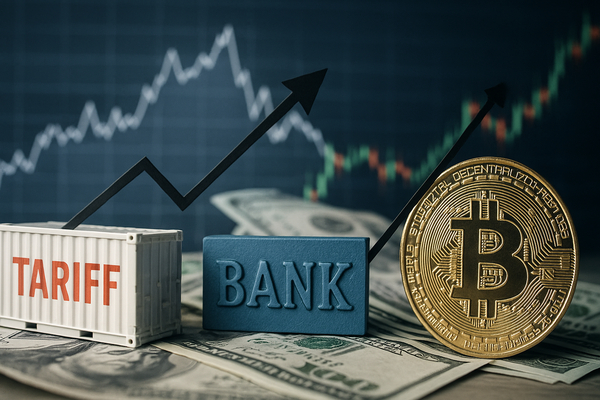
Friday’s headlines left investors with a clear message: policy noise can still move markets, and when it does the effects are fast and broad. A presidential post threatening “a massive increase” in tariffs on Chinese imports sent volatility spiking across equity and derivative markets, pushing the CBOE Market Volatility Index up roughly 32% in intraday trading. Equities tumbled, regional banks and select financial names registered outsized losses, and asset managers and insurers found themselves parsing both balance-sheet exposure and fast-changing investor flows.
Tariff scare and a volatility snap: how the market reacted
The immediate market reaction was both technical and thematic. Traders bid up options to hedge directional risk and derivatives desks saw volumes spike — not the least of which was at CME Group, where metals trading recorded an all-time daily volume of 2,148,990 contracts on October 9, 2025, a 24% jump versus the prior record of 1,728,362 contracts. That type of trading activity speaks to two things at once: risk-management demand from institutional players and renewed speculative interest where macro headlines create short-term directional uncertainty.
Regional financials were disproportionately affected. Bank of America, for example, closed the session down 2.27% at $48.66, and a raft of regional banks reported heavy selling pressure as investors fretted that tariffs could ultimately slow trade and dent loan growth in exposed markets. Analysts and strategists quickly turned their attention to the start of third-quarter earnings season, which now assumes even greater importance as a reality check on balance sheets and revenue resiliency.
Bank earnings, balance-sheet risk and concentrated exposures
Big banks will be front and center next week, and the calendar could not be more consequential. JPMorgan Chase, Goldman Sachs, Wells Fargo and Citigroup are due to report early in the cycle, offering investors a chance to compare trading and investment-banking results against retail and commercial lending trends. Independent research suggests U.S. banks are expected to record a roughly 10% annual increase in third-quarter core earnings, according to RBC — a number that will be pressure-tested by macro headwinds and headline-driven market gyrations.
Credit events outside the bank universe have also created immediate spillovers. The bankruptcy of First Brands Group has produced a cascade of claims and redemption requests that expose multiple institutions. Jefferies and UBS have been cited as potentially facing losses in the billions due to involvement with First Brands receivables, and reports indicate UBS may hold more than $500 million of exposures. Asset managers reacted rapidly: Morgan Stanley’s asset-management arm requested to redeem investments tied to a Jefferies fund with heavy First Brands exposure. That combination of direct counterparty risk and the second-order effects of forced liquidations helps explain why certain credit-sensitive names and regional banks traded lower.
Investors will be scrutinizing loan-loss provisions, trading revenue, fee income and deposit trends as banks report. Regional lenders without sizable trading franchises are more exposed to any macro slowdown tied to trade tensions, which is why names with outsized regional concentration underperformed the broader financial indices on the tariff news day.
Where capital is moving: private credit, ETFs and crypto flows
One of the longer-term themes that persisted through the headlines is the reallocation of capital into alternative credit and structural solutions. Retail-oriented private-credit funds now control more than $213 billion — up nearly 50% in the past year, according to Goldman Sachs. That flow tells a story about investor demand for yield and differentiated income streams even as traditional banking spreads remain pressured.
At the same time, public markets are processing new structures and products that alter the mechanics of capital allocation. Bitcoin exchange-traded funds have crossed a cumulative $5 billion in net inflows, marking a swift capital rotation into crypto exposure via regulated, exchange-listed wrappers. BlackRock’s ETF suite has been in the spotlight as Bitcoin products top profit charts, while Coinbase has been aggressive on multiple fronts: pursuing a national trust charter, striking retail partnerships (including a three-month Coinbase One trial for hundreds of millions of Samsung users in the U.S.), and reportedly being among the suitors in a bidding contest for BVNK, a stablecoin infrastructure provider that has also drawn interest from payments incumbents.
These moves are not just headline-grabbing; they are changing the revenue calculus for large asset managers and banks. BlackRock and other managers are increasingly monetizing index/ETF scale while also chasing growth in private markets and tech-enabled products. The asset-manager playbook was on display with Victory Capital’s recent financing actions: the company extended and repriced debt facilities, refinancing $985 million in term loans and extending a $100 million revolving credit facility maturity to support strategic flexibility — an example of balance-sheet management that financial executives highlight as critical when market volatility reappears.
And while crypto inflows accelerate, traditional market structure is also shifting. Cboe is expanding into Australia for listings and product distribution, intensifying competition in market infrastructure. Those initiatives add options for issuers and increase fee pools for operators, just as trading volumes in certain venues surge.
Not all action is in high finance. Corporate social responsibility and branding continue to matter. Aflac Global Investments’ team recently raised more than $28,000 for pediatric cancer research, a reminder that capital firms and corporate teams still anchor reputational capital to community efforts even as they wrestle with market turbulence.
The net effect is clear: price action this week was a function of immediate policy noise layered on top of structural changes in how capital is raised, allocated and monetized. Investors watching earnings and liquidity metrics will gain the clearest read on which institutions can absorb headline shocks and which may feel the aftershocks. For asset managers and fintechs, the interplay between product innovation — from ETFs to stablecoins — and the regulatory environment will determine which players win the next phase of institutionalization.
For now, market participants are left with a simple set of priorities: quantify direct exposures to headline events, reassess earnings and capital plans in light of higher option-implied volatility, and watch how flows into alternatives and crypto products either accelerate or pause as policymakers and courts process the week’s headlines. In an environment where policy statements can move the VIX by a third in a session, that attention to detail may be the most valuable risk-management tool of all.












